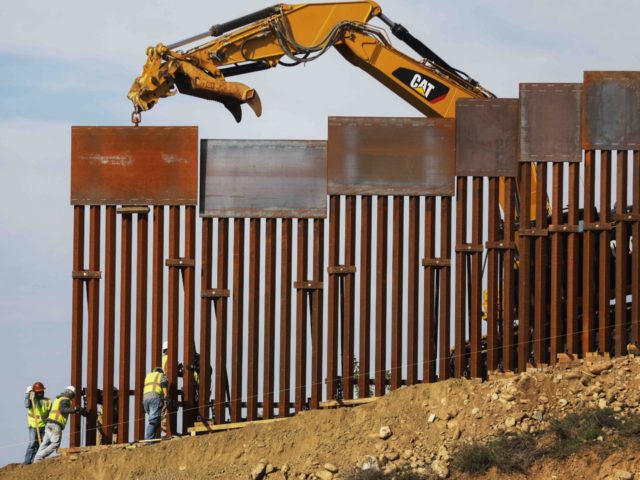President Donald Trump can likely begin building new sections of the border barrier, despite a federal lawsuit filed by California and 15 other states on Monday challenging the the national emergency declaration he issued Friday.
The reason: only some — about $3.6 billion — of the roughly $8 billion Trump wants to spend on the barrier actually requires an emergency to be declared in order to be allocated. The rest, theoretically, can be spent regardless — especially the $1.4 billion Congress approved, though it is subject to some restrictions that may not apply to the rest of the money.
Conn Carroll, communications director for Sen. Mike Lee (R-UT), explained the reasoning on Twitter Friday:
Some quick notes on early coverage of President Trump’s announcement today that pretty much all reporters are missing 1/
— Conn Carroll (@conncarroll) February 15, 2019
The WH did not make one executive action today. In reality they made three, only one of which involved an emergency declaration. 2/
— Conn Carroll (@conncarroll) February 15, 2019
First the WH announced they would be funding $601 million in wall construction from the Treasury Forfeiture Fund, relying on 31 U.S.C. § 9705. This does not require an emergency declaration. 3/
— Conn Carroll (@conncarroll) February 15, 2019
Second, the WH announced they would be funding $2.5 billion in wall construction under 10 U.S.C. § 284 (this is MilCon $ for combating drug trafficking). This does not require an emergency declaration. 4/
— Conn Carroll (@conncarroll) February 15, 2019
Finally, the WH announced they would be funding $3.6 billion under 10 U.S.C. § 2808. This money does require an emergency declaration. 5/
— Conn Carroll (@conncarroll) February 15, 2019
According to the WH this money will be spent sequentially so the § 9705 money will be spent first then the § 284 money then the § 2808 money. 6/
— Conn Carroll (@conncarroll) February 15, 2019
So depending on how fast they can begin construction, they will have to spend over $5 billion (including the $1.3 billion in fencing appropriations) before any of the emergency money is ever tapped 7/
— Conn Carroll (@conncarroll) February 15, 2019
The complaint filed by California and other states on Monday in federal court affirms Carroll’s explanation — albeit inadvertently.
Though the states are trying to stop Trump from spending most of the $8 billion, their arguments largely rest on policy grounds — i.e. the argument that “an emergency declaration is not necessary” — that require the courts to set aside the president’s judgment on national security in favor of the judgment of state-level attorneys general.
The complaint acknowledges (footnote omitted):
The Administration identified the following funding for diversion:
- $601 million from the Treasury Forfeiture Fund;
- Up to $2.5 billion under the Department of Defense funds transferred for Support for Counterdrug Activities (10 U.S.C. § 284); and
- Up to $3.6 billion reallocated from Department of Defense military construction projects under the President’s declaration of a national emergency (10 U.S.C. § 2808).
That funding ($7.1 billion) is in addition to the nearly $1.4 billion Congress authorized under the border deal — which is available to be spent immediately.
The $3.6 billion that is covered by the emergency declaration would only be available, the complaint argues, if a national emergency actually existed — which the plaintiffs insist, citing various political arguments, it does not.
As for the rest, the complaint acknowledges that the other sources of funding are “not dependent on the president declaring a national emergency,” but argues that a border barrier would not stop the smuggling of drugs, or lower crime.
It also argues that the environmental impact of the barrier in New Mexico and California requires the federal agencies involved to prepare environmental impact statements under the National Environmental Policy Act (NEPA). But the new barrier will likely be built in Texas, and Texas is not a party to the lawsuit.
These are not particularly strong legal arguments. The plaintiffs make the constitutional case that the president’s powers are at their “lowest ebb” if he “acts contrary to the expressed or implied will of Congress,” but stumble over the fact that Congress has, in fact, now appropriated funds for a border barrier. Trump just wants more of it, and his decisions to re-direct funding not covered by the emergency declaration cite laws passed by Congress to allow the president to do exactly that.
Moreover, because the administration plans to spend the emergency funds last, the case may not even yet be ripe enough for adjudication.
It may be that the Northern District of California, and the Ninth Circuit, side with the plaintiff states’ arguments against the emergency. But even so, the courts are unlikely to stop all of the spending on the wall.
Therefore the Trump administration can likely begin building the new barrier — today.
Joel B. Pollak is Senior Editor-at-Large at Breitbart News. He is a winner of the 2018 Robert Novak Journalism Alumni Fellowship. He is also the co-author of How Trump Won: The Inside Story of a Revolution, which is available from Regnery. Follow him on Twitter at @joelpollak.

COMMENTS
Please let us know if you're having issues with commenting.